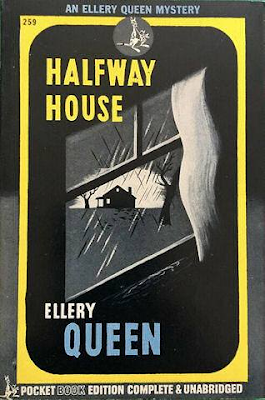Tuesday, November 8, 2022
Halfway House (1936) by Ellery Queen
Tuesday, March 15, 2016
If A Body Meet A Body, George Malcolm-Smith, Reviewed by Margaret Redfern, April 26, 1959
Monday, July 20, 2015
Eighty Million Eyes, Ed McBain, Reviewed by Anthony Boucher
"Ed McBain comes up with an excellent answer in EIGHTY MILLION EYES (Delacorte, $3.50): take two novelettes and combine them into a contrapuntal novel, so that each story heightens the suspense and casts light upon the theme of the ether. The titular novelette (1963) is about the poisoning (by the unusual means of strophanthin) of a major TV comic while on camera; "The Dear Hunter" (1965) is about a psychotic mam of violence who takes over control of the life of a girl he has never met. Each is very good in itself; combined, expanded and developed, they add up to the best book about the 87th Precinct in several years."
Monday, July 13, 2015
Friday, July 10, 2015
Thursday, July 2, 2015
Sunday, June 28, 2015
Cat of Many Tails, Ellery Queen, Reviewed by Anthony Boucher
By Anthony Boucher, New York Times, October 9, 1949.
“A detective novel," wrote S.S. Van Dine in 1928 should contain no long descriptive passages, no literary dallying with side-issues, no subtly worked-out character analyses, no ‘atmospheric. preoccupations.’ And Ellery Queen, making his debut the following year, loyally obeyed Van Dine’s dictum, But the detective novel, thank heaven, has in the past twenty years grown far away from the sterile smugness of Van Dine and Ellery Queen has grown up with it.
“Queen has not followed the trends of the times so closely as to succumb to the amorphous plotlessness of the current "suspense novel"; "Cat of Many Tails" presents the puzzle-minded reader with a very pretty problem indeed. And it includes a brand-new solution to one of the fine classic gambits, the hidden motive underlying an apparently unrelated series of murders. It then goes on to probe the psychology behind the puzzle, with Ellery as an odd sort of lay deductive analyst.
“But what you will most remember the novel for is its ‘descriptive passages’ and ‘atmospheric’ preoccupations. If the human characters still betray a touch of the bloodlessness of the Van Dine era, the actual protagonist of the novel, the City of New York, comes magnificently to life. The impact of mass murder on the soul of a city has never, that I can recall, been depicted with such convincing vividness. Even the benighted few who have hitherto deplored the artificiality of the Queen saga will find a new scope and stature in ‘Cat of Many Tails.’”










